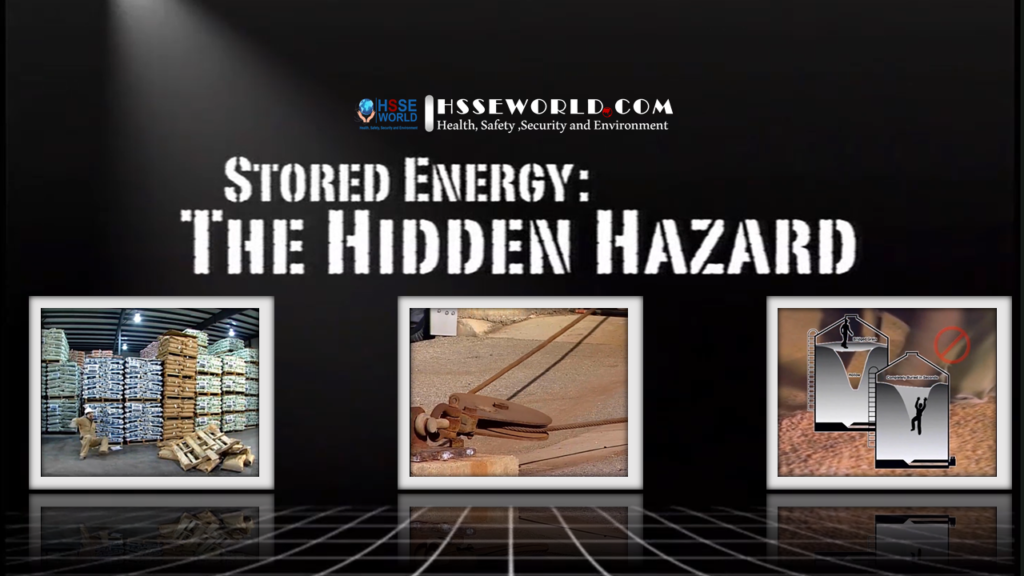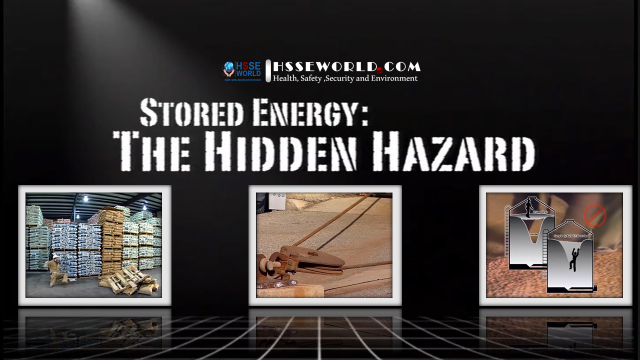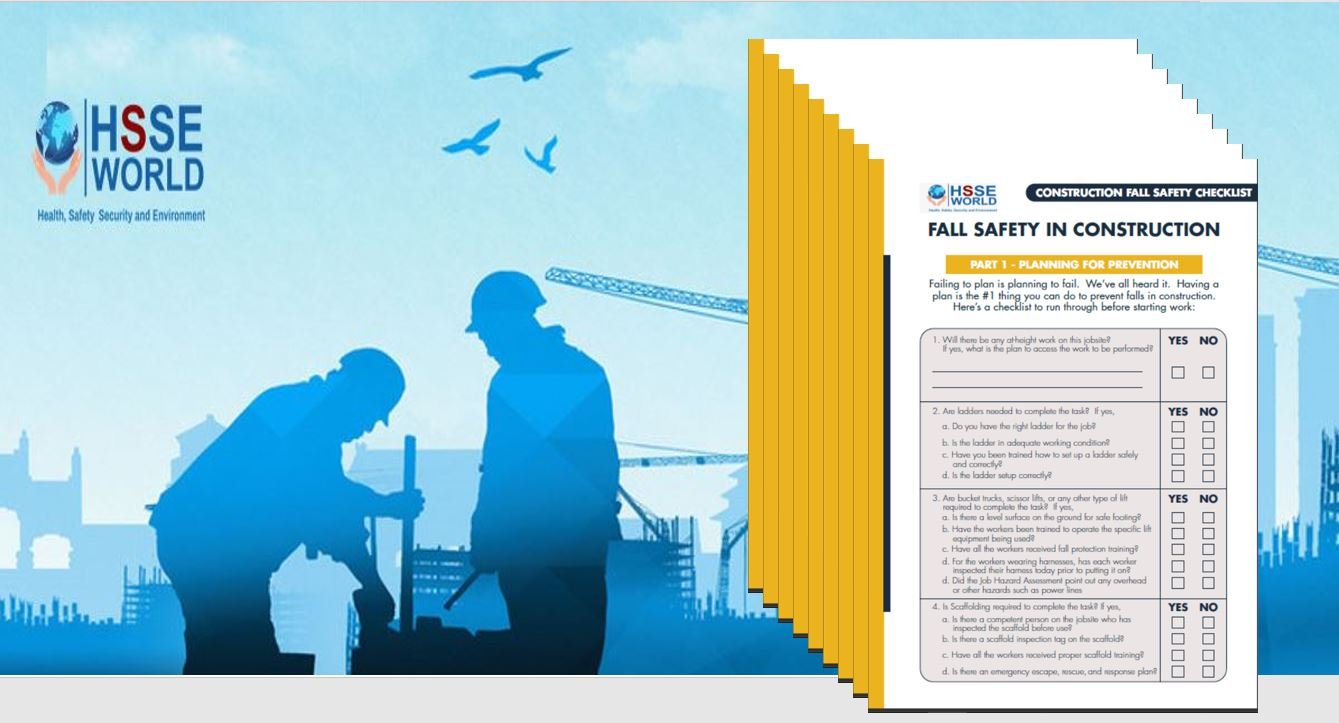While most people think about lockout hazards when discussing “stored energy,” potential and elastic stored energy can also be very dangerous. This Video is designed to raise your employees’ awareness of all types of stored energy hazards in the work environments where they can be found.
- What the various types of stored energy are and the hazards they present.
- Stored energy hazards found in receiving areas.
- The dangers of products that are stored in bulk.
- Hazards of loaded pallets and other warehouse equipment.
( for more learning watch the Video Below )

Introduction
The video begins with a scene in a warehouse where a forklift operator has just placed a loaded pallet in an unstable position at the top of a stack. An employee passing by is intently studying some paperwork and fails to notice the unstable pallet. Suddenly the pallet shifts and plunges from the top of the stack. At the last instant, the employee sees the load hurtling down at him and he quickly jumps back as the massive load crashes to the floor in front of him.
Electrical and Mechanical Stored Energy
The narrator explains that equipment such as motors, control panels, conveyors, and hydraulic systems contain electrical and mechanical stored energy.
Weight = Stored Energy
But there’s another kind of stored energy we might be less familiar with: The sheer weight of things in our workplaces, such as loaded pallets, heavy equipment, and bulk material such as grain, salt, or animal feed. That weight is a type of stored energy, also called potential energy. The higher the object is from the ground, the greater its’ stored energy.
Elastic Stored Energy
Another kind of stored energy to be aware of is called “elastic stored energy.” For example, when a bungee cord is slack it contains no stored energy. But when it gets stretched out, the energy needed to stretch it is stored there until it’s released. In the workplace, the same kind of energy – in much greater quantities – can be found in ropes and cables that are used to move heavy objects and equipment. Unfortunately, potential energy and elastic stored energy can be a source of serious injuries and fatalities at some facilities.
Awareness and Observation
To protect ourselves we can increase our awareness of stored energy hazards and we can become more observant of them in our surroundings. But, every workplace is different and the hazards can change from day to day. The video next explores some actual workplaces to identify real stored energy hazards.
Receiving Areas
The video illustrates various scenes in receiving areas, such as dock plates, trucks, railcars, and forklifts moving products. Viewers are invited to identify the stored energy hazards in the scenes.
Dock Leveler Mishap
The video next illustrates a mishap that could result from these hazards. A worker raises a dock leveler as a truck backs up. A person on the dock is standing too close to the leveler. When the leveler drops, it lands on the toe of the worker’s boot. Next, the right way procedure is illustrated. The operator makes sure the person is clear before lowering the leveler.
Ocean Containers and Trucks
Ocean containers and trucks that unload products through rear doors are another sources of hazards. When opening the doors, the weight of the material can cause it to suddenly spill out, or force a door open and cause an injury. Trucks that raise their hopper to unload material also present a stored energy hazard. If a hydraulic or mechanical failure happened while the hoper was raised, it could suddenly drop. Bottom dumping hopper trucks, which are much safer because the hopper remains stationary while the material unloads from the underside.
Rail Car Safety
Rail cars are another potential source of stored energy hazards.
- Car Pullers – Some locations move cars into position using car pullers. As the winch pulls the car, huge amounts of elastic stored energy builds up in the cable. If the cable broke or came loose, the energy in the cable would be released with explosive force. The video illustrates a series of guards that help protect the operator from a broken cable.
The video also explains the following car puller safety procedures.
When attaching the hook to the car, be careful to avoid pinch points.
- Inspect the anchor point, hook, clamps, sheaves, for any loose, frayed, or damaged conditions. Make sure the tracks are clear of obstructions, including snow or ice.
- Check that the deadhead pulley and the winch are in good operating condition.
- Make sure that all personnel are clear from the cable’s line of fire.
- Turn on the alarm or warning light 10 seconds before moving the car. Some car puller systems have an automatic alarm system that sounds an alarm when the puller is activated. A timer then delays the operation of the puller for 10-15 seconds while the alarm sounds.
- Boxcar Doors
Before opening doors, be sure the boxcar wheel is chocked and set the manual brake. Place a blue flag in front of the car; indicating work is taking place inside the car. Then check the door rail system for damage.
Boxcar door handles may contain stored energy that could cause it to quickly turn on its own, possibly injuring an operator. To manage this hazard, the video illustrates the following procedures:
One person should open the latch while another person maintains a firm grip on the handle.
- When using a come-along or chain puller, hook the lever end to a sturdy anchor point near the ladder, but not to the ladder. Inspect for wear or damage before using it. Connect the hook to a strong anchor point on the door. Keep personnel away from the “fall area” of the door. Position your body away from the line of fire of the cable.
- Bulkhead Doors
Some boxcars may have bulkhead doors inside that slide on rails. The hazard occurs if someone tries rocking a jammed door to dislodge it. Doors have come off their rails and fallen on people, causing serious injuries and deaths. It’s important to follow the safety procedures for inspecting and moving doors. If a door jams or is difficult to move, contact the railroad service crew or reject the car.
Bulk Storage
The video illustrates several bulk storage areas, including flat storage grain, grain in large bins and salt in large mounds.
A. Weight of Bulk Product
At first glance, the products stored in bins or large mounds don’t look especially dangerous. But think about the amount of weight – the stored energy – in the material. Just one cubic yard of salt or grain weighs about 1,300
– 2,000 pounds, or about 600 – 900 kilograms. This is an approximate amount for some types of salt and grain.
Note: Different types of salt and grain have varying weights, some of which are greater than the weights described in the video. For example, the Salt Institute explains that de-icing salt weighs 72-84 pounds per cubic foot. That equals 1,944 – 2,268 pounds per cubic yard. (1,153 – 1,345 Kg/cubic meter)
B. Salt Mound Collapse
A worker is walking past a large salt mound with a steep wall of salt where it has been excavated. Suddenly a section of the face collapses, knocking down and burying the worker. The narrator explains the importance of staying a safe distance from the face of a storage mound or bin. If the product appears unstable, notify your supervisor so the problem can be corrected.
C. Grain Bins
Grain bins are another place where stored energy can turn deadly. Tragedy most often strikes when someone enters a bin and attempts to dislodge grain that’s bridged or caked. Grain can fall on the person and bury them, or they can break through the bridged grain and get buried or pulled into the flowing grain. If it becomes necessary to enter a bin, carefully follow the confined space entry procedures for bin entry.
The video includes graphic depictions of bridged and caked grain in bins. Also included is a scene of a person entering a bin while following the correct confined space entry procedures.
D. Tragic True Story
The video next features a man recounting the story of his brother who became trapped in a grain bin.
“My brother’s name was Wayne. He was a truck driver for the competitor. Driving a feed truck, delivering feed to the farms. Helping in the feed mill. Whatever needed to be done. He was basically like a “jack of all trades.
Growing up, I couldn’t have asked for a better friend. He and I fought like brothers normally do. We always worked together as a family, that’s the way our mom and dad were. We worked together on the farm and we played together. And my brother, he would have done almost anything for anybody.
No one knows when he entered this bin. They found him there, the second shift personnel found him about 5:30, 6:00 in the evening. Everyone else had left the facility and had gone home. They looked out and they saw my brother’s car still there, wondering how come that car was still there? That’s when they started looking for him. That’s when he looked in the bin and saw just his hand sticking out of that corn.
You know that you have an opportunity to make the right choice or the wrong choice. And that can determine what tomorrow is going to bring. My brother, made a very poor choice, when he entered that bin or whether he just shoveled on the bin without the fall protection on. But, we have policies and procedures, they’re all in place. At this facility, all of the policies and procedures were in place. They knew what they were supposed to do, but they were not followed. And that’s when it comes back to individual choices.
You know, there is nothing that I can change about what happened with my brother, but if through this video if someone watching changes the way that they do things, and this changes their life, then, you know, in a sense with my brother, I believe that something good can come out of this whole situation.
Warehouses
The video illustrates a variety of warehouse scenes, including forklifts moving and stacking pallet loads of product. Viewers are asked how many stored energy hazards they can see.
A.Loaded Pallets
Pallets loaded with products can be a serious stored energy hazard. What makes them a potential hazard is their weight; combined with the height they’re stacked. For example, a pallet load of 50-pound (23 kilograms) bags can easily weigh 2,500 pounds (1,134 kilograms) – about the weight of a small car. The higher the pallet is from the floor, the more stored energy it contains.
B.Identifying and Correcting Pallet Hazard
The scene of the unstable pallet from the opening of the video is replayed. The person walking in the aisle is looking around the warehouse is being observant of his surroundings and he notices the leaning pallet. He calls to a forklift operator who drives up and adjusts the unstable pallet.
C.Moving Heavy Equipment
Another commonly stored energy hazard involves transporting heavy equipment or parts. To transport this material safely, use equipment that can safely handle the weight.
Maintenance Areas
The video illustrates a variety of scenes in a maintenance area, such as a worker using a hoist to lift a motor, shelves holding boxes of equipment, a large hammer resting on the top of a ladder, steel beams and rods on a rack, a big wood box on top of a rack, and a TV monitor sitting on a mezzanine above a desk. Viewers are asked to see how many stored energy hazards they can identify.
A.Computer Monitor Falls
A person on the mezzanine is moving some equipment. Nearby is the computer monitor sitting close to the edge of the mezzanine. A woman begins doing some work at the desk below. The worker on the mezzanine bumps the monitor while moving a pallet, sending the monitor crashing to the floor within inches of the woman working at the desk. Next, the correct procedures are illustrated, as the person working on the mezzanine sees the monitor and moves it to a safer location.
Stored Energy Hazards Away From the Workplace
Awareness of stored energy hazards goes beyond the workplace. In fact, our homes often contain stored energy hazards that we can easily overlook. Things such as bookshelves, heavy furniture and large TV’s can become serious hazards. The U.S. Consumer Product Safety Commission estimates that in 2005, at least 3,000 children under the age of 5 were admitted to U.S. hospital emergency rooms after televisions tipped over on them.
Between 2004-2005, more than 100 deaths – mostly young children – were caused by falling furniture or televisions.
Conclusion
Whether we’re at work or at home, the variety of stored energy hazards we can encounter is nearly endless, and the hazards can change from day to day. So the key to our safety is awareness – awareness of the hazards we could encounter and awareness of our surroundings. This awareness will help us to either eliminate stored energy hazards or stay out of their line of fire. We’ll not only protect ourselves, but we’ll also protect the well-being of our co-workers and our family members as well.
Watch The Video :
More videoes
- Creating safety in welding operations
- Video: Ladder Safety-A Practical Approach
- Video: Stored Energy
- Video: Hydrogen Sulfide Employee Training
- Video: Protecting our sight
- Video: Supported Scaffolding Safety
- Preventing Fires During Hot Work Operations
- Video: Lockout – Tagout Safety Training
- Video: Preventing Heat-Related Illnesses
- Video: Your Personal Fall Arrest System: Surviving the Fall
- Accident Investigation for Everyone
- Video: Fire Prevention & Response
- RCRA Hazardous Waste Final Rule: The E-Manifest System & Other Key Revisions
- Video: Avoiding line of Fire: Safety Moment#36
- Video: Employee safety in confined spaces
- Video: Aerial Work Platform Safety: Safety Moment#35
- Tips to Avoid Standstill Accidents: Safety Moment#33
- Common Causes of the workplace incident: Safety Moment#32
- Evaluating the Effectiveness of Leading Indicators and Developing High-Impact for safety
- Machinery Guarding: Safety Moment#31
- Electrical Safety While Working From Home: Safety Moment#30
- Dehydration in cold weather
- Lifting Calc 3: Safety APP
- Video: Working safely Near powerlines -Safety Moment#26
- Video: Winter’s Hidden Hazard -Safety Moment#25
- Video: Isocyanates Exposure -Safety Moment#24
- Video: Electrical Safety Awareness -Safety Moment#23
- Safety Flash: Laborer Dies After Footing Collapse – North Carolina
- Risk Assessment Training and Application tool
- Falls from heights :Video-Safety Moment #14
- The Golden safety rules :Video-Safety Moment #12
- Incident Report Form
- Video:Accident Investigation-1
- Slips,Trips and Falls checklist
- scaffold-Power fatility
- Nitrogen Hazard lead to Fatal Accident




